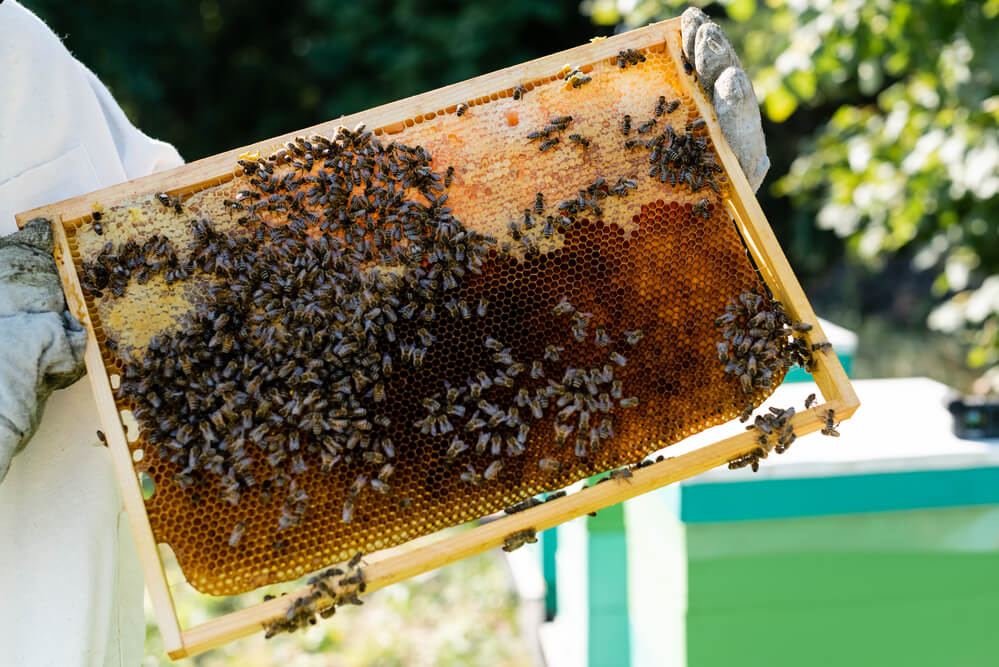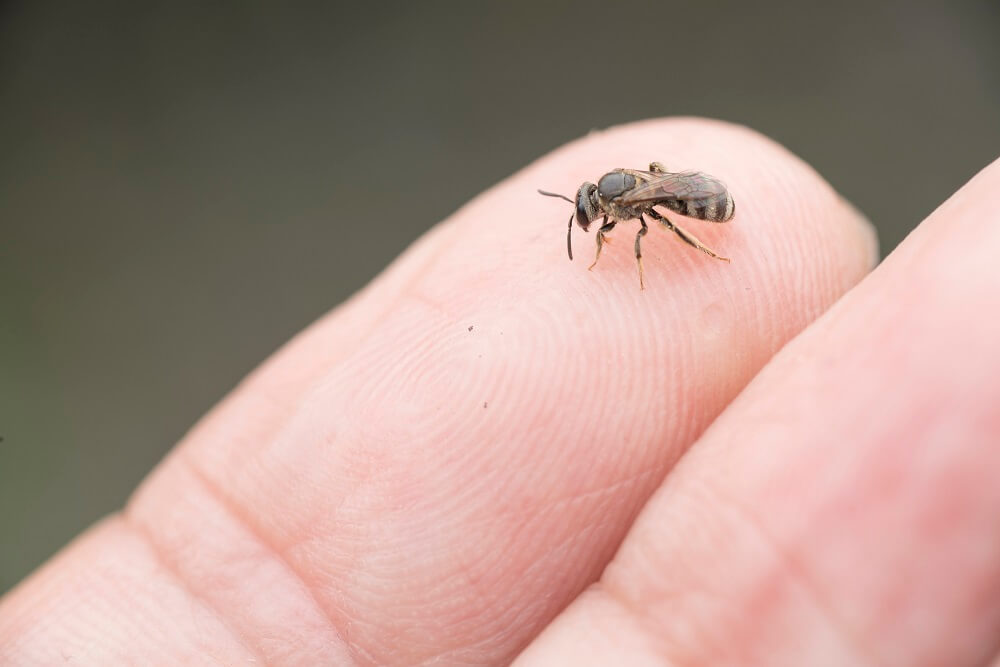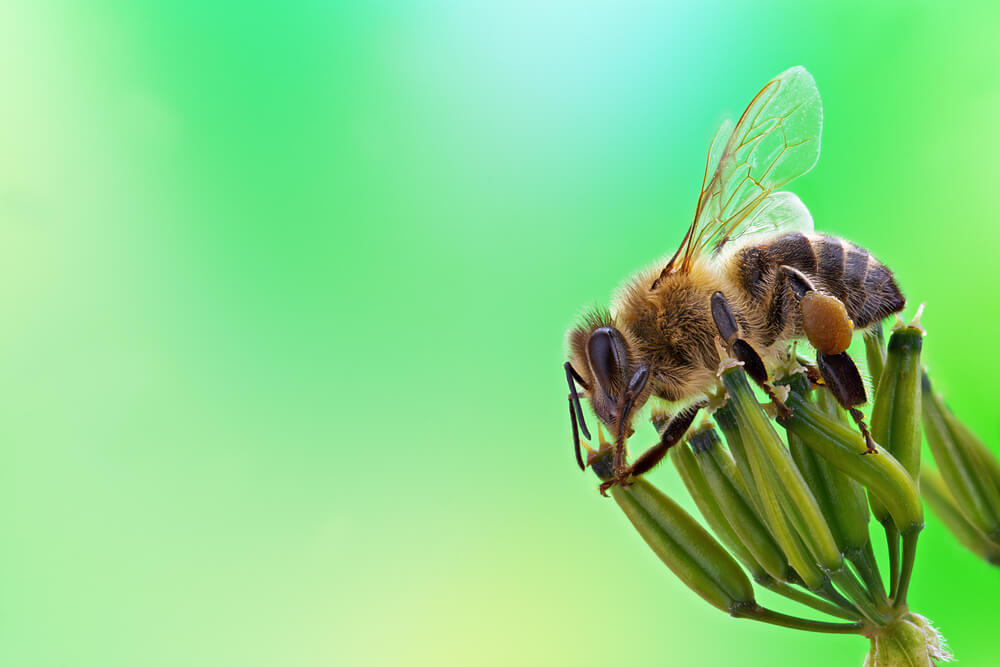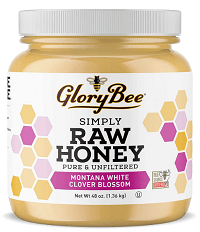Table of Contents:
How Do Bees Produce Honey?
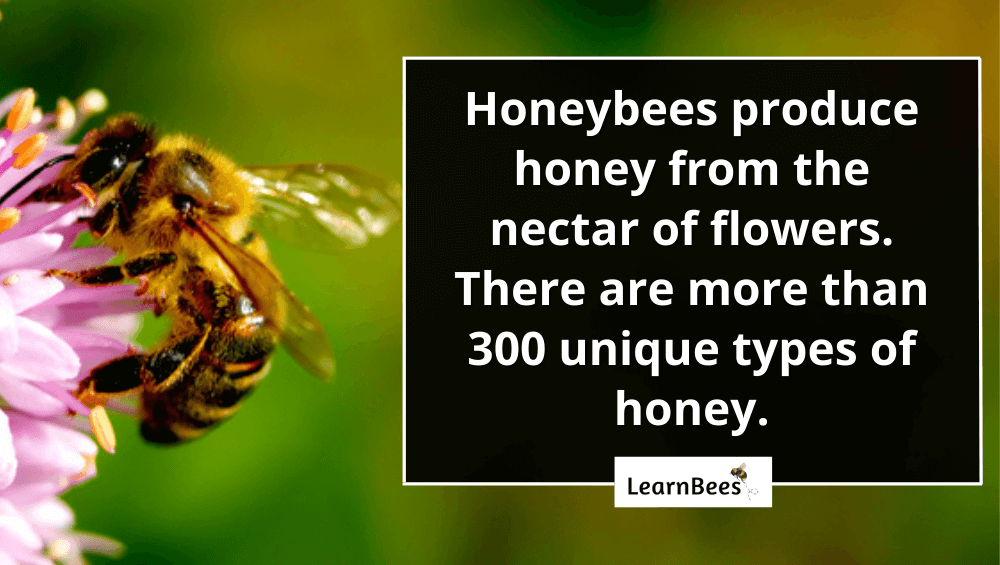
Bees produce raw honey to eat when flowers are scarce, such as during summer droughts or winter.
But how do they do it?
The short answer is that bees mix nectar with special enzymes from their saliva. This special enzyme turns the nectar into honey.
From there, the bees reduce the water content of the honey and store it inside the honeycomb to eat later.
But now you might be asking:
What is the full honey making process, step by step?
It all begins with forager bees.
Forager bees are tasked with leaving the hive to collect food for their family. You see, a bee’s primary diet includes pollen and nectar from flowers.
More specifically, nectar is a sweet liquid produced by plants that entice bees and other pollinators to their flowers.
Bees slurp the nectar using their tongues and hold it inside their ‘honey crop.’ The honey crop is an internal organ bees use to store things temporarily.
And here’s the fascinating part:
Bees have a special enzyme in their saliva called invertase. This enzyme is unique and magical because it transforms nectar into honey.
Once the bee has a full load of nectar stored inside their honey crop, they fly back to their hive to drop it off.
Once back at the nest, the forager bees regurgitate the nectar out of their honey crop and into the mouths of the other bees at the nest.
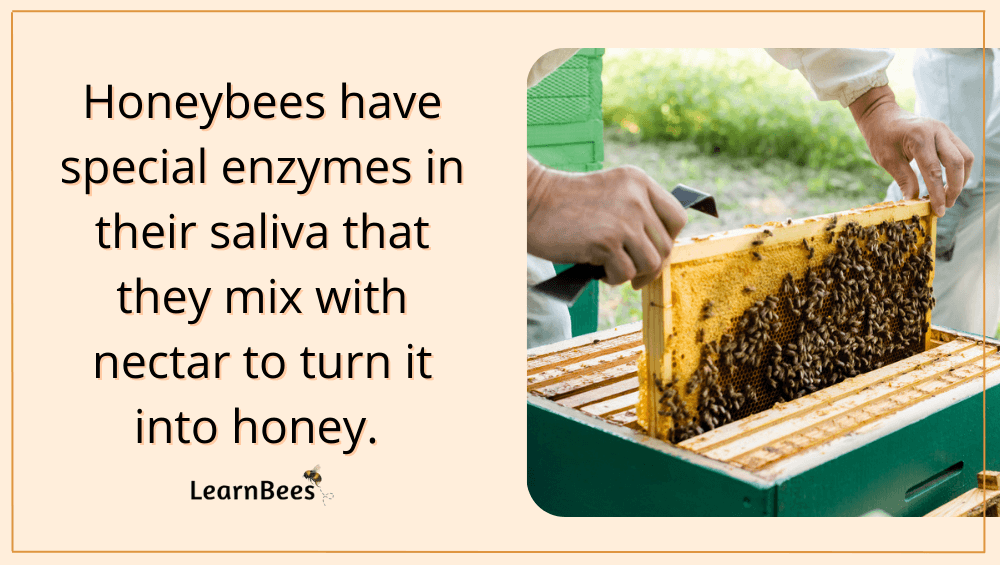
The bees that gather the nectar at the nest are called ‘house bees.’ House bees are tasked with cleaning the hive, caring for the baby bees, and completing the honey making process.
And what happens next?
The house bees add more special enzymes to the nectar until it completely transforms into honey. Once finished, the bees regurgitate the honey into the honeycomb cells to store it.
But the honey is still watery at this point, so the bees help reduce the moisture content by fanning their wings. This “dries out” the honey and thickens it into syrupy, sweet goodness.
Finally, the bees cover the honeycomb cells with a wax lid to keep the honey sealed and clean.
That’s it.
That’s how bees produce raw honey.
In summary, here’s a step-by-step list of how bees make honey:
- Step One: Forager bees gather nectar from flowers and hold it inside their honey crop
- Step Two: The bees fly back to their nest and give the house bees the nectar
- Step Three: The house bees transform the nectar into honey by using a special enzyme in their saliva called “invertase”
- Step Four: The bees store the honey inside the honeycomb, then fan their wings over it to reduce the excess water content
- Step Five: Once the honey thickens, the bees cover the honeycomb with wax to seal it
What Are Honey Making Bees Called?
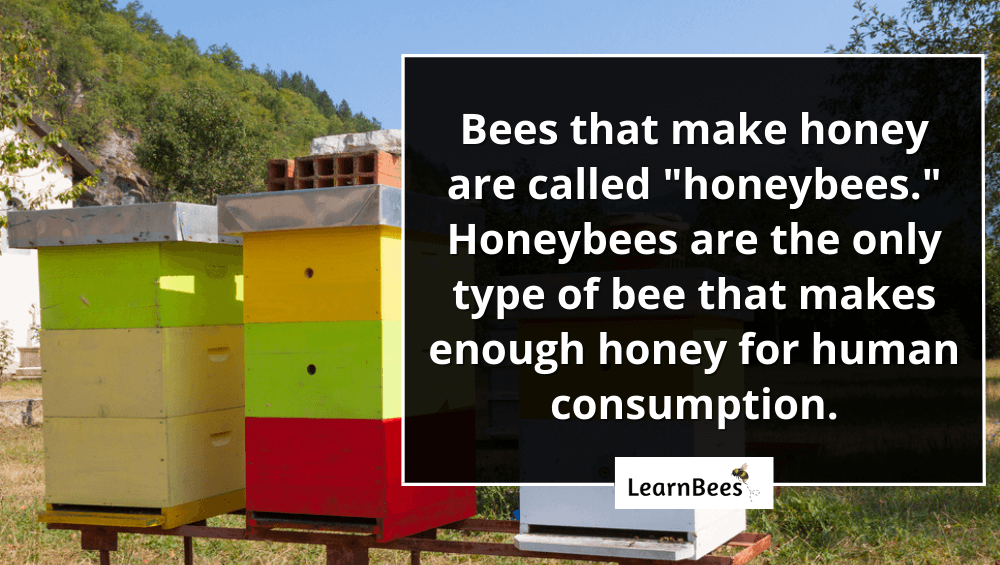
It’s the million-dollar question:
What type of bee makes honey?
Bees that produce honey are referred to as “honeybees.”
Honeybees produce the raw honey you buy at grocery stores, farmers’ markets, or online. Honey comes in over 300 unique varieties – all ranging in color, taste, and texture.
For example, raw blueberry honey has a smooth buttery texture with hints of blueberry. It gets its fruity undertones because the honeybees pollinate blueberry bushes.
In contrast, raw eucalyptus honey has a distinguishable herbal flavor. It has hints of caramel and menthol. A spoonful of eucalyptus honey is ideal for opening up the sinuses and soothing sore throats.
But here’s the thing:
Honeybees aren’t the only types of bees that produce honey.
Bumblebees are another well-known species of bee that makes honey to feed their colony. With that said, bumblebees have smaller colonies than honeybees, so they don’t produce nearly as much honey.
For example, a healthy honeybee colony can contain 50,000 to 60,000 honeybees.
On the other hand, bumblebee colonies typically only have between 50 to 400 bumblebees.
Huge difference.
So as a result, honeybees produce much more honey than bumblebees because they have thousands of mouths to feed. This is why a single honeybee hive can make up to 100 pounds of honey per year.
It also explains why the raw honey you see at the grocery store solely comes from honeybees. They’re the only type of bee that produces enough honey for mass human consumption.
How Long Does it Take Bees to Make Honey?
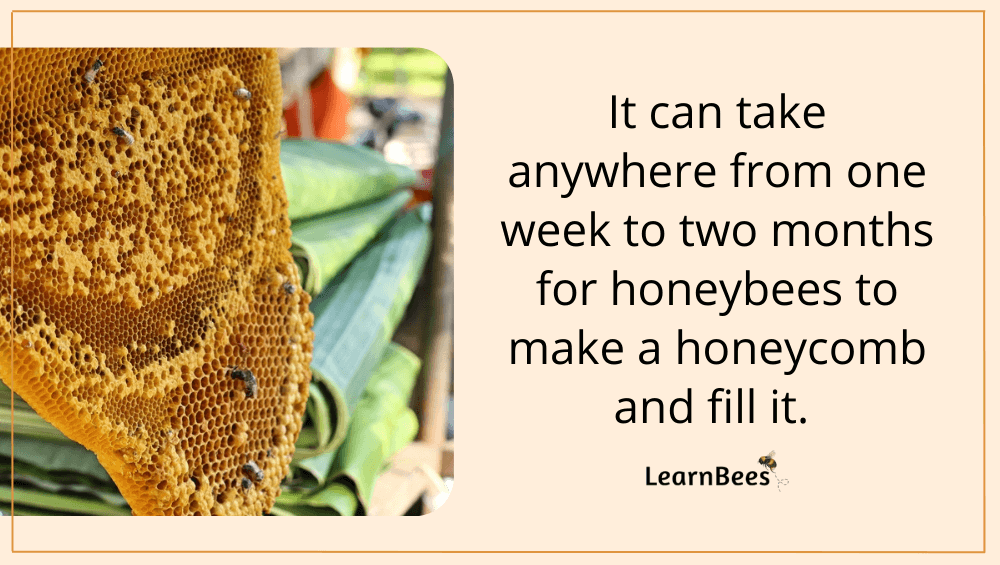
It depends.
It depends on how big the colony is and if there is plenty of nectar available for the bees to collect.
On average, the honey making process takes between one week to 2 months for the bees to make a honeycomb and fill it with honey.
That said, honeybees will start the process of making honey immediately. They waste zero time. But the size of the colony and flower availibility greatly affect how much honey they can produce in a short amount of time.
For example, larger colonies of 50,000 or more honeybees have plenty of helping hands to make large quantities of honey. They can make a pound or more of honey in just two to three weeks.
On the other hand, smaller colonies take longer.
But that’s not all.
Honey flow also dictates how fast bees can produce raw honey.
A good honey flow happens when one or more abundant nectar sources are available to the bees. This includes plenty of flowers for the bees to pollinate and warm and sunny weather conditions.
Here’s the thing to remember:
Bees get their food solely from flowers.
Unlike wasps, bees don’t eat other insects. They rely on flowers for nectar and pollen. This is why planting a pollinator-friendly garden is so beneficial for bees. You can provide them with a reliable food source while also encouraging pollination.
Pollination allows plants to reproduce and create fruits, vegetables, and seeds. This benefits the plant, animals, and humans that rely on plants for food.
FAQs on Honey Making Bees
- What type of bee makes honey?
- Do bees really make honey?
- Do bees get harmed when making honey?
- Can humans make honey?
- How many times a year can you harvest honey?
- How many bees are needed to make a jar of honey?
- How do bees survive if we take their honey?
- Do beekeepers add sugar to honey?
- How much honey do you get from one hive?
What type of bee makes honey?
The type of bee that makes the most honey is called a honeybee (Apis mellifera). This bee species is native to Europe, Africa, and the Middle East.
Honeybees were brought to North America by early settlers in the 1600s. They are now the most common type of bee in North America.
Honeybees aren’t the only bees that make honey. There are also stingless bees and bumblebees. However, these species don’t produce nearly as much honey as honeybees.
Why?
Because honeybees have large colonies with tens of thousands of bees in them. A single honeybee hive can contain as many as 50,000 honeybees. Meanwhile, a bumblebee colony typically holds less than 400 bumblebees.
This difference in colony size means that honeybees can gather more nectar and make more honey than other types of bees. This also explains why all honey sold at grocery stores comes from honeybees. Bumblebees and other types of bees don’t make enough honey for human consumption.
—> Go back to the FAQs on honey making bees
More to Explore:
Do bees really make honey?
Yes, but not all species of bees produce honey.
In fact, most types of bees don’t produce honey.
Honeybees, bumblebees, and certain kinds of stingless bees are the exception. They produce honey to help feed their colony when nectar sources are low.
As we mentioned, the type of bee that makes the most honey is the honeybee. These bees can produce large quantities of honey because they live in large colonies. A single honeybee hive can have as many as 50,000 or more bees.
Other types of bees, like mason bees, don’t produce honey. They simply collect their food daily from flowers. They have short lifespans and live alone – unlike honeybees and bumblebees who live in colonies.
—> Go back to the FAQs on honey making bees
More to Explore:
Do bees get harmed when making honey?
No, bees don’t harm themselves while producing honey. In fact, they actually benefit from the process because they use honey for food.
Without honey, honeybees could not survive the harsh winter months. They would starve to death because they wouldn’t have access to nectar or pollen since most flowers don’t bloom when it’s cold.
You see, honey is like a bee’s “rainy day fund.” They make enough to survive when food sources are scarce. This is why beekeepers only harvest a portion of the honeybee’s honey, so they have plenty to last through the winter.
—> Go back to the FAQs on honey making bees
More to Explore:
Can humans make honey?
Humans can produce a honey-like substance, but it’s not considered real honey.
Raw honey is a sugary, sweet liquid produced by insects. Most honey is made from the nectar of flowers, which is a sweet substance that bees collect.
Bees consume the nectar and store it in their honey crops. Enzymes in the bee’s saliva break down the nectar, which causes it to turn into honey. The honey is then regurgitated and stored in the hive.
Humans don’t have enzymes in our digestive system that can break down flower nectar. So, we can’t produce honey like bees do.
—> Go back to the FAQs on honey making bees
More to Explore:
How many times a year can you harvest honey?
It depends on the climate, strength of the hive, and nectar availability in a particular area.
For example, beekeepers may be able to harvest two or three times per year in warmer regions of the United States. Places like Florida or California have mild winters that allow the bees to have a longer active season.
In contrast, places like Minnesota or Alaska have colder and longer winters. This means that the bees have a shorter active season, which limits the number of times beekeepers can harvest honey.
In general, most beekeepers can harvest honey at least once per year.
—> Go back to the FAQs on honey making bees
More to Explore:
How many bees are needed to make a jar of honey?
It’s hard to say exactly how many bees are needed to produce a jar of honey.
With that said, it’s believed that a single bee can make 1/12 of a teaspoon of honey. This means that 12 bees are needed to produce one teaspoon of honey.
An eight-ounce jar of honey contains 48 teaspoons, so that would take 576 honeybees to produce a jar of honey.
12 bees x 48 teaspoons (8 ounces) = 576 bees
—> Go back to the FAQs on honey making bees
More to Explore:
How do bees survive if we take their honey?
Beekeepers are only supposed to take a portion of the bee’s honey, so it leaves enough behind for them to eat. For instance, beekeepers in northern climates will leave 80 or 90 pounds of honey behind for the bees.
In southern climates, beekeepers will leave behind about 50 pounds of honey for bees. This is because southern climates are warmer and less harsh. Therefore, honeybees don’t need as much honey to make it through the winter.
With that in mind, beekeepers don’t harvest honey from new beehives during their first year. Why? Because honeybees need at least one year to establish themselves enough to produce a surplus of honey.
—> Go back to the FAQs on honey making bees
More to Explore:
Do beekeepers add sugar to honey?
No.
Beekeepers don’t – and shouldn’t – add sugar to their honey. Honey is sweet enough on its own without adding sugar to it.
That said, some beekeepers feed their bees sugar water during times of nectar dearth. However, beekeepers only collect and harvest honey made from nectar. Bees can turn sugar water into a honey-like product, but it’s not real honey.
—> Go back to the FAQs on honey making bees
More to Explore:
- Ground Bees: Are They a Threat to Your Yard?
- Wasps vs. Honeybees: Are They Different?
- Do Bumble Bees Bite?
How much honey do you get from one hive? How much honey do bees make?
The amount of honey bees produce varies between hives.
A strong hive can produce 100 pounds of honey.
But remember:
It’s not how much honey you can get from your hive but how much honey you need to leave.
The amount of honey you leave depends on several things, including your climate and how much honey the bees have in storage. For instance, cooler climates require you to leave behind more honey for the bees.
